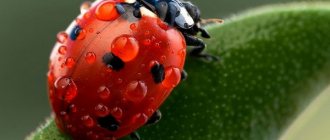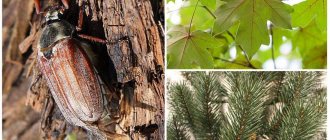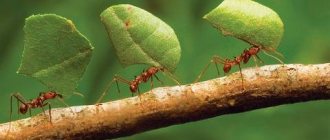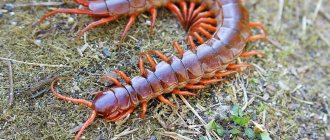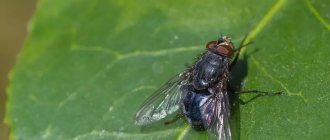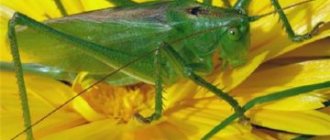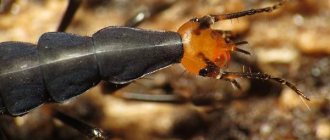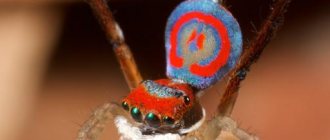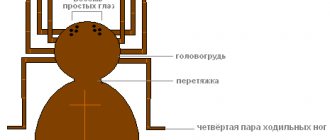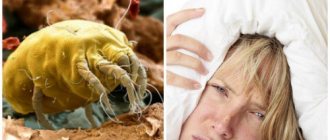May beetles or May Khrushchi – lat. Melolontha hippocastani, representatives of the phylum arthropods, belong to the class insects. May beetles appear in the spring, most often in late April - May, hence the name “May beetles”. If at this time you look closely at the young, still short grass, you will notice that here and there beetles crawl out of the ground after wintering and fly into the air. On quiet, warm spring evenings, cockchafers can be observed very often. They sit on trees, especially birch, horse chestnut, maple, apple, and pear trees, and gnaw off the leaves on them, sometimes bare. If gardens are blooming at this time, then May beetles land on the flowers and damage them. During the day, these beetles are usually invisible: they sit on trees, clinging to branches with their legs.
The structure of the May beetle (Khrushchev)
The body of the cockchafer, like the body of the crayfish and the cross spider, is covered with a chitinous shell. The body and limbs of the cockchafer are segmented. Already from these signs it is clear that the beetle belongs to the phylum of arthropods. But its body is dissected differently than that of the crayfish and spider. It is divided into three sections: head, chest and abdomen. The chest consists of three segments, and the abdomen has eight.
The limbs of the cockchafer, like other insects, are located on the head and chest. Insects have no limbs on their abdomen.
Appearance and habitat
What does the cockchafer consist of? Like all insects, the structure of the cockchafer includes a chitinous covering in the form of a shell, which plays the role of protection from environmental irritants, and also acts as a kind of skeleton. The maximum size of the beetle is usually up to three and a half centimeters.
Adult representatives of the cockchafer often differ in their color. Of the entire color range, two variations stand out: rex - red body with a reddish tint to the legs and pronotum; nigripes - legs and pronotum are black. Such chromatism is considered an ecological form of the cockchafer's structure. Those individuals that are red and orange live in places open to the sun, while black ones live mainly in dark places in medium-density forests. Accordingly, reds predominate in the south, and blacks predominate in the north of the country.
Being part of the world of insects, the cockchafer prefers forest-steppes and forest belts with young pine trees; within city limits they are found among artificially planted plants, as well as among trees and shrubs that are flowering and fruitful. It is trees and shrubs that are considered the main place for mating, after which the female lays eggs in the soil, burrowing there with her head.
External structure of the May beetle (Khrushchev)
Like all insects, the May beetle has three pairs of legs, one pair on each of the three thorax segments. Each leg consists of several movable segments and ends with claws, with which the beetle clings to the leaves and bark of trees. In addition, with its front legs the beetle digs the ground, where the females lay their eggs. That's why these legs are very strong and resemble strong scrapers.
When the cockchafer sits quietly, only the first of its three thoracic segments is visible. Two pairs of wings are attached to the other two thoracic segments. The wings of beetles are not the same in structure and importance. Hard brown elytra are attached to the second thorax segment, and a pair of large translucent flying wings are attached to the third. Like all beetles, the cockchafer has only its hind wings for flight. The front wings support the beetle's body during flight. Before flying, the beetle raises its elytra and begins to breathe heavily. Having taken in air, the beetle spreads its wings and flies into the air. The cockchafer is a clumsy insect; it flies slowly, heavily and, moreover, mainly in the evenings.
Fighting the cockchafer using traditional methods
During the period of the highest activity of the insect, that is, with the appearance of adult individuals, they can be caught by shaking them from trees and bushes. It is best to do this early in the morning, when the cockchafer is in a torpor due to the overnight drop in ambient temperature. Searching for the May beetle for collection and destruction You can also reduce the number of the beetle and its larvae using homemade traps: A shallow container (plastic or metal basin) is dug into the ground in an open area near areas with vegetation or trees and smeared from the inside with grease or special glue for insects
At night, a light source of medium power is installed at the bottom of the basin prepared in this way. In the morning, you will have to dispose of an entire army of insects with your own hands, including many individuals of the cockchafer, which ran up and flew into the light and successfully stuck to the walls of the trap. The neck is cut off from a regular plastic bottle, and 4 holes are made in the walls around the circumference. A cord is threaded through them, by which the trap is suspended among the branches of fruit trees. Then pour a little bread kvass or fermented jam into the bottom. Traps should be checked regularly, adding bait liquids and removing dead insects. Soap trap for beetles Under the lamp, fixed among the branches of garden trees, there is a small container of water, into which a little kerosene should be added.
Trap for the cockchafer The destruction of the cockchafer can be entrusted to poultry. Of course, you shouldn’t let it out into the garden, otherwise the vegetation will be destroyed along with the pests. However, there is no quicker way to get rid of hand-collected larvae and dead adult beetles than by pouring them into a chicken feeder. If walnuts grow on your site, you can safely include a decoction of its leaves in your arsenal of means to combat beetleworm and its larvae.
Internal structure of the May beetle (Khrushchev)
The cockchafer's mouth is located on the underside of its head. Pieces of plant food, which the beetle bites off and crushes with its jaws, enter the pharynx through the mouth. From the pharynx, food enters the long esophagus, part of which, expanding, forms a goiter. The food then enters the chewing stomach. In the chewing stomach of the cockchafer, like that of the crayfish, there are hard chitinous plates that are driven by special muscles. These plates completely grind the food. From the chewing stomach, food enters in small portions into the middle intestine, the so-called digestive stomach. Here, under the influence of digestive juices, food is digested and absorbed in liquid form. Undigested food debris from the midgut enters the hindgut, ending in the anus. This hole is located at the end of the abdomen. Through it, the remains of undigested food are removed from the insect’s body.
Sense organs of the May beetle (Khrushchev)
In the external environment, the cockchafer navigates with the help of its senses. These organs are located on his head. In insects they are better developed. The beetle has organs of touch, smell and vision. The long antennae play the role of olfactory organs in the beetle. Mainly with the help of smell, cockchafers find food. The sense of smell in insects is well developed. Sometimes chafers fly to single trees at a distance of over a kilometer in search of food. The organs of touch in the cockchafer, like in other beetles, are the palps of the oral appendages. May beetles use them to feel for food.
The cockchafer's vision is also well developed. Protruding eyes are placed on the sides of his head. Like the crayfish, the cockchafer's eyes are complex. Each eye consists of approximately 8,000 individual ocelli. Other insects have even more of them. In dragonflies there are up to 20,000 of them, and in some butterflies even up to 27,000. Each eye individually sees only a part of this or that object. Yet together they give a general idea of the world around us. Since the individual eyes are facing in different directions, the beetle immediately sees everything that is happening around. Thus, the compound eye is a well-developed organ of vision, which is especially important for such clumsy insects as the cockchafer.
Varieties of Khrushchev
- White . Covered with chalky scales, which makes the beetle appear to have a light color. In fact, it is brown. The male will look lighter than the female due to the more dense arrangement of scales. The size of the species is large, up to 3.5 cm. Habitat: Central Asia and steppe strips of the Russian Federation. There is a lot of it on the Azov coast and in Crimea. Loves sandy surfaces and is found in desert and coastal dunes. Lives for about 3 years. It destroys berry crops, vineyards, fruit-bearing trees and potato plantings, eating and damaging their root system.
- Eastern (wild chestnut) . Small in comparison with other species, 2.9 cm. The body is in the shape of an oblong ellipse, dark, brown with red. The head is speckled, the shine is not strong. It is known for its very large larva, up to 6.5 cm. It has an orange head and a white body (which is curved “C”). The larva is voracious and omnivorous. Eats the roots of vegetables, cereals, shrubs, especially young ones. Often attacks greenhouses and nurseries. Adults feed on leaves, including needles. Lives up to 5 years.
- Western . Similar to the eastern one, but larger (3.2 cm). The stocky body, widened on the sides, in the form of an oval, extends downwards. The color palette ranges from light to almost black. There are light triangles on the sides of the abdomen. Larvae with a brown head and a dirty yellow body. Their size is 4.5-6.5 cm. It eats the roots of plants and trees, cereals, herbs, berries, and potatoes. Adult beetles gnaw the foliage of fruit and nut trees, poplars, willows, and alders. They feed on needles only when there is a shortage of other food sources. They live throughout the European part, including the CIS countries. Life expectancy is 4 years.
- June (summer root gnawer) . The smallest type (2 cm). The body color is brown, covered with thick yellow hairs. The larva is no longer than 4.4 cm. They do not tolerate dampness and settle only in sandy places. The brown-headed white larva is omnivorous and voracious. The beetle lives 2-3 years.
Respiratory organs of the May beetle (Khrushchev)
The respiratory organs of the cockchafer, like all other insects, are not similar to the respiratory organs of crayfish and other animals. As a rule, insects live on land. They breathe atmospheric air.
Therefore, they lost the gills characteristic of crayfish as aquatic animals.
In the body of the cockchafer, like all other insects, there are many thin tubes through which air is distributed to all organs. These breathing tubes are called tracheae. Air enters the insect's body through special openings on the sides of the body, called spiracles. The cockchafer has 9 pairs of spiracles. They are located on the segments of the chest and abdomen. The walls of the trachea contain spiral chitinous filaments. This ensures free access of air to every organ, to all tissues of the cockchafer’s body.
The benefits and harms of the cockchafer
Since beetle larvae feed on plant roots, they cause serious damage to agricultural crops. Growing larvae actively feed throughout the growing season; they have no special food preferences; they like cereals, vegetables, fruit trees and shrubs. If measures are not taken, the larvae can lead to the death of many plants; seedlings and young trees are at particular risk.
Adults eat leaves and flowers. They weaken the plants and damage the ovaries, which leads to a significant reduction in yield. The cockchafer is also dangerous because it does not leave the selected area if there is something to profit from there. That is, the insect will remain in the garden, systematically destroying the inflorescences and leaves of plants.
If we talk about the benefits of the May beetle, we can only mention that these insects are a food supply for many birds and insectivorous animals, and the period of activity of the beetles coincides with the time of birth and growth of chicks and cubs. As for benefits to people, chafer larvae are an excellent bait used by fishermen. An adult insect can also become bait for fish.
Circulatory organs of the May beetle (Khrushchev)
Oxygen enters the body organs through the trachea. Unlike other animals, insects' blood carries only nutrients from the digestive organs throughout the body. Therefore, the circulatory system of insects has a fairly simple structure.
The blood of insects is colorless. Just like the crayfish, the cockchafer's heart is located on the dorsal side of the body. It resembles a long tube and consists of a number of separate chambers. The muscles attached to them extend from the chambers to the sides. This allows the chambers to contract and force blood forward into a long blood vessel, the aorta. From the aorta, blood does not flow further through closed tubes - blood vessels - as in many other animals and humans, but directly flows into the spaces between the organs and spreads throughout the body. Blood is then collected back into the heart through holes in the chambers. Thus, like crayfish and mollusks, the cockchafer, like all insects, has an open circulatory system.
Internal organs
The internal structure of the Khrushchev has both common features for lamellar and some characteristic differences.
The high degree of development of the organs and systems of the cockchafer allows it to adapt to changing living conditions and wintering in the soil, as well as increase the survival rate of the species.
Digestive system
An adult May beetle has powerful jaws. With the upper, pointed part, it bites off pieces of leaves, and with the lower, jagged part, it crushes them. The food then passes through the esophagus and enters the stomach. There are chitinous teeth that grind the leaves into pulp. Processed food enters the intestines, where it is finally digested and absorbed. Undigested residues are excreted from the body through the anus in the pygidium.
Circulatory system
The insect has an open circulatory system. Blood is located directly in the body cavity and washes tissues and organs. It transports nutrients from the intestines to the tissues, and metabolic products from the tissues to the excretory organs.
The movement of blood to the head occurs due to the pulsation of the heart - a muscular tube located along the back of the insect. Blood is “taken” from the back during expansion of the heart through holes in the side walls. The valves then close, preventing blood from flowing out. In the body cavity, everything happens the other way around: blood moves from the head to the back, and when it reaches the heart, it flows in the opposite direction.
Respiratory system
The beetle's respiratory system consists of external spiracles and a dense network of tracheae. The air enters the spiracles and is delivered through the trachea to the tissues and internal organs. The spiracles can be seen on the edges of the dorsal part of the abdomen, raising the wings and elytra.
Excretory organs
The excretory system is a bundle of thin tubes located in the body cavity - Malpighian vessels. On one side they are connected to the intestines, on the other they are “sealed”. Metabolic by-products are filtered through the surface of the vessels, which turn into crystals inside. These crystals then travel to the intestines, where they mix with undigested food and are expelled through the anus. The most dangerous compounds that enter the insect’s body are sent to the fat body and are utilized there.
Nervous system
The structure of the nervous system of the cockchafer is typical of arthropods. Its main elements are the peripharyngeal nerve ring and the ventral nerve cord.
The complex neural connections in the parapharyngeal ganglion are at such a level of development that some scientists identify this organ with the brain.
Reproductive system
In females, the reproductive system is represented by the following organs:
- seminal receptacle - a reservoir for spermatozoa;
- a pair of ovaries that produce eggs;
- tubular oviducts;
- an unpaired oviduct through which mature eggs move outward.
In males, the reproductive system consists of:
- two testes that produce germ cells;
- vas deferens;
- unpaired ejaculatory duct, designed for the removal of sperm.
Nervous system of the May beetle (Khrushchev)
The nervous system of the cockchafer and other insects is similar to the nervous system of the crayfish, but has a more complex structure. Like cancer, it is located on the ventral side of the body and looks like an abdominal nerve cord. Around the pharynx it forms a peripharyngeal nerve ring. However, unlike cancer, the nerve ganglia are not distributed evenly throughout the body, but merge into several large nodes. Due to the strong development of the sensory organs, the peripharyngeal nerve ring reaches a particularly large size.
The fusion of the nerve ganglia and the large size of the peripharyngeal nerve ring indicate a higher degree of organization in insects compared to crustaceans. In insects we encounter the most complex manifestations of nervous activity among all invertebrates. This is often found in the very complex instincts and behavior of these animals.
Instincts are very complex reflexes. They are produced in animals during the process of their historical development and are one of the forms of adaptation to living conditions.
The place of the cockchafer in the insect kingdom
The second name of the hero of today's conversation is May Khrushchev. The Coleoptera insect belongs to the Lamellaridae family, the Khrushchi subfamily, of which there are more than 5.7 thousand species on the planet.
Despite its impressive appearance, it is a pest that poses the greatest threat to deciduous and mixed forests, but it does not disdain cultivated fruit and berry trees. Even more dangerous is the larva, which is popularly called hrobak, furrowworm. Depending on the habitat of the cockchafer, it, gnawing the root system, destroys young forest plantations, grains, garden crops, and seedlings.
The distribution range of various types of Khrushchev is Europe and Asia, wherever forests grow in abundance. In Russia, the insect is found from Arkhangelsk to Yakutsk, but prefers the center and south of the European part, Siberia.
Nutrition of the May beetle (Khrushchev)
On the front of the cockchafer's head there is a pair of segmented antennae, elongated into long plates. This feature distinguishes insects from crayfish, which have two pairs of antennae, and arachnids, which do not have them at all. Along the edges of the mouth there are modified limbs - oral appendages that look like chitinous plates. There are three pairs of them. They form the chewing organs of the cockchafer, adapted for feeding on solid plant food (eating leaves, etc.). Of these organs, the first pair - the upper jaws or mandibles - plays a particularly important role in feeding. May beetles feed on plant matter. They eat tree leaves. The second pair of oral appendages are called the mandibles. They each have one segmented palp. The third pair has grown together and forms the so-called lower lip. A pair of palps also extends from it. On top, the movable oral appendages are covered with a small plate - the upper lip. The cockchafer bites off food with its mandibles and partly with its lower jaws. The mandibles crush food, and the lower tube supports it. Both pairs of palps continuously palpate and move food towards the mouth. If you cut off the palps of a cockchafer, it will not be able to eat.
How to catch chub using a cockchafer?
But for fishermen, May beetles are a real value, because they can be used to catch some species of fish. Catching chub with a cockchafer occurs as follows. We cast the fishing rod, lower the line and wait for the bite. The bait should not move...
You will quickly feel the bite and hook. But don’t rush to pull out the chub, let him walk with the bait. Chub is a good catch using a cockchafer wobbler. The cockchafer wobbler is an artificial but effective bait.
Reproduction of the cockchafer
Like all other arthropods, the cockchafer reproduces exclusively sexually. May beetles are dioecious animals. Females have developed ovaries, consisting of thin-walled tubes filled with translucent female reproductive cells - eggs. Female cockchafers lay eggs in the soil, burrowing to a depth of 20–30, and sometimes 50 cm. Each female lays up to 70 fairly large eggs.
Having laid eggs, the females die here in the ground. The testes of males look like two long convoluted white tubes. Males die earlier than females.
Life cycle, reproduction and lifespan
May beetles are insects with complete metamorphosis; their life cycle is divided into 4 stages of development:
- egg (duration 30 – 40 days);
- larva (duration 3-4 years);
- pupa (duration 30 – 60 days);
- imago (live 1.5 – 2 months).
Reproduction of cockchafers occurs at the end of May. Soon after mating, the male dies, and the fertilized female digs a tunnel in the ground to a depth of at least 30 cm and lays eggs there. During her life, the female can lay from 20 to 70 eggs, after which she dies.
Khrushchev larvae look like fat caterpillars. They have a large head, 3 pairs of limbs, and a white and yellow curved body. The larvae live underground at a depth of 20–50 cm, and for the winter they burrow to a depth of 1.5 m. There is a difference in what the larvae of the cockchafer eat in the first year of life and in the second or third year. Newly hatched larvae mainly eat plant debris and humus, while older ones actively destroy plant roots and root crops.
Development cycle
After 3-4 years, closer to autumn, the larva climbs deeper and turns into a pupa. The adult insect that emerges from the pupa remains underground and emerges only with the arrival of stable warmth - in late April or early May.
May beetle (chafer) larvae
A month and a half after the eggs were laid, larvae emerge from them and live in the ground for three to four years. Such worm-like larvae are popularly called “boroznyaki” in Ukraine. They do not look at all like adult cockchafers. The larvae are adapted to life in soil. Thanks to the worm-like shape of the body, they move easily in it. Like most animals that live in the dark, the larvae of cockchafers are white in color. They have no eyes. Using strong, pincer-like upper jaws, the cockchafer larva digs the ground and gnaws the roots of the plants on which it feeds. The head and legs of the cockchafer larva are covered with a durable chitinous shell, which has a protective value.
In the first year of their life, the larvae of the cockchafer feed on various plant debris, and in the second, and especially in the third year of life, they gnaw through the roots of various plants and gnaw root crops.
The larva grows, molts several times, and at the end of the last year of life in the ground, in June–July, it enters the next stage of development, turning into a pupa. In appearance, the pupa resembles a beetle, but it is colorless, soft, with very short wings. The pupa does not move or grow, but complex processes occur under its covers: wings, legs and other organs characteristic of an adult insect develop.
After one to two months (late July - August), the pupae turn into adult beetles. May beetles remain overwintering in the soil and only emerge from the ground the following spring.
The chafer is characterized by development with complete transformation. When the egg is completely metamorphosed, a worm-like larva develops first, which in its structure differs sharply from the adult insect. The larva grows, after which it turns into a pupa and, finally, into an adult insect. Development with complete transformation, like that of cockchafers, is also characteristic of many other insects - beetles, butterflies, house flies, etc. The presence of a worm-like larval stage in the development of the cockchafer and other beetles, as well as butterflies, flies and many other insects, shows that insects in the process of historical development descended from worms.
Reproduction and development
After fertilization, the female cockchafer burrows into the soil and lays eggs there.
Larva
Larvae emerge from the eggs at the end of summer. Neither in appearance nor in their way of life they are at all similar to adult beetles. The thick whitish body of the larva is arched and covered with a soft chitinous cover. More dense yellowish-brown chitinous covering on the large head and three pairs of legs. The wings of the larva are not developed. The spiracles are visible on the sides of the body. In the back of the abdomen, an intestine filled with earth is visible: young larvae feed on humus. In autumn, the larvae go deep into the soil and overwinter. In the spring of next year they rise to the soil surface, where during the summer they eat the roots of herbaceous plants and pine seedlings. The larvae spend the winter again deep in the soil. The following summer (third year of development), the grown larvae eat the roots of bushes and trees.
Doll
Having overwintered for the third time and grown greatly, at the end of spring the larva goes deeper into the soil and, shedding its larval cover, turns into a pupa. It looks like an adult insect. On it you can distinguish a head with mouthparts and antennae, compound eyes, legs folded on the chest of the pupa, and small wings are noticeable. The chitinous cover is quite dense, but uncolored. The pupa can move its abdomen slightly, but is not able to move or feed. This is a resting stage in development. Under the chitinous cover of the pupa, complex changes occur due to the nutrients accumulated by the larva, leading to the development of all organs of the adult insect. By autumn, the skin of the pupa bursts, and an adult beetle emerges from it with soft, colorless covers, which soon harden and acquire a characteristic color.
The beetles remain overwintering in the ground and come to the surface only in the spring of next year.
